You’ll preserve your precious metal clay effectively by storing it in stable temperatures between 15-25°C and maintaining humidity below 50%. Keep your PMC in archival-quality, dust-free containers away from UV light exposure. Use vacuum packaging to prevent oxidation and contamination, while conducting regular inventory checks to catch deterioration early. Proper workspace organization and consistent environmental controls are essential for maintaining PMC’s workability and preventing costly material loss. Master these fundamentals to access advanced conservation strategies.
Understanding Precious Metal Clay Composition and Vulnerability
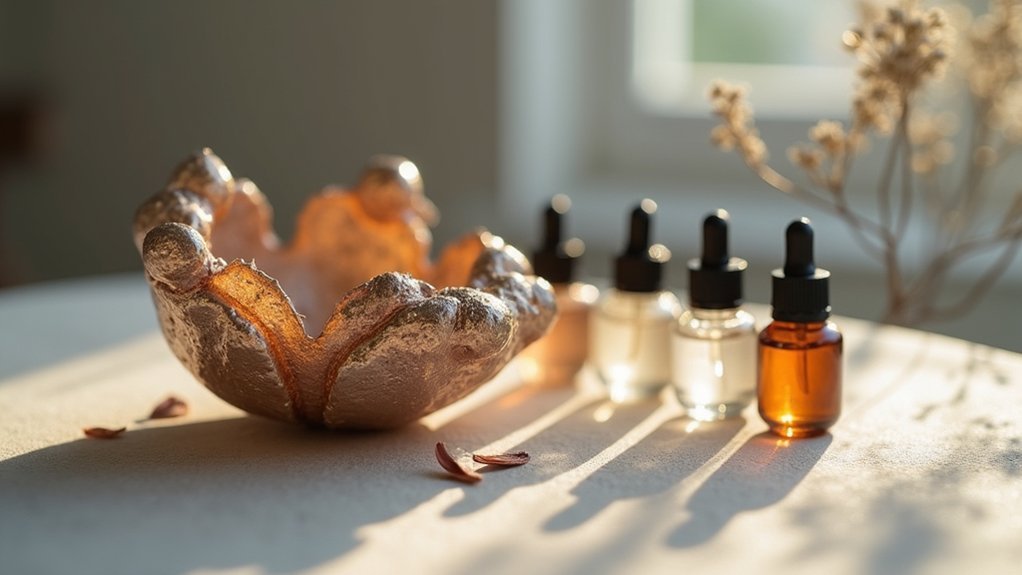
Craftsmanship meets chemistry when you work with Precious Metal Clay, a revolutionary material that transforms from a moldable substance into solid metal through careful handling and firing.
PMC’s composition consists of fine metal particles—typically silver—bound together with organic binders and water. This unique blend gives you clay-like workability before firing.
Fine metal particles suspended in organic binders create PMC’s remarkable clay-like properties that disappear completely during the firing process.
However, you’ll need to understand PMC’s vulnerabilities to preserve its quality. Humidity directly affects the material’s consistency and workability, while temperature fluctuations can compromise its structural integrity.
The organic binders that make PMC moldable will burn away during firing, leaving behind pure metal that’s over 92.5% silver.
You must recognize these environmental sensitivities to maintain PMC’s performance and guarantee your finished pieces meet professional standards.
Proper Storage Environment for PMC Materials
Since environmental factors can make or break your PMC projects, you’ll need to establish precise storage conditions that protect the material’s integrity.
Creating a proper storage environment requires careful attention to several critical factors that directly impact your precious metal clay’s longevity.
Follow these essential storage guidelines:
- Temperature Control: Maintain consistent temperatures between 15-25°C (59-77°F) to prevent material degradation.
- Humidity Management: Keep humidity levels below 50% to avoid moisture damage, mold growth, and warping.
- Clean Environment: Store materials in dust-free spaces using archival-quality containers for maximum protection.
- Adequate Lighting: Use UV-filtered fluorescent bulbs to minimize harmful light exposure.
Regular inventory checks guarantee you’ll catch deterioration early, allowing for timely preservation actions when needed.
Temperature and Humidity Control Methods
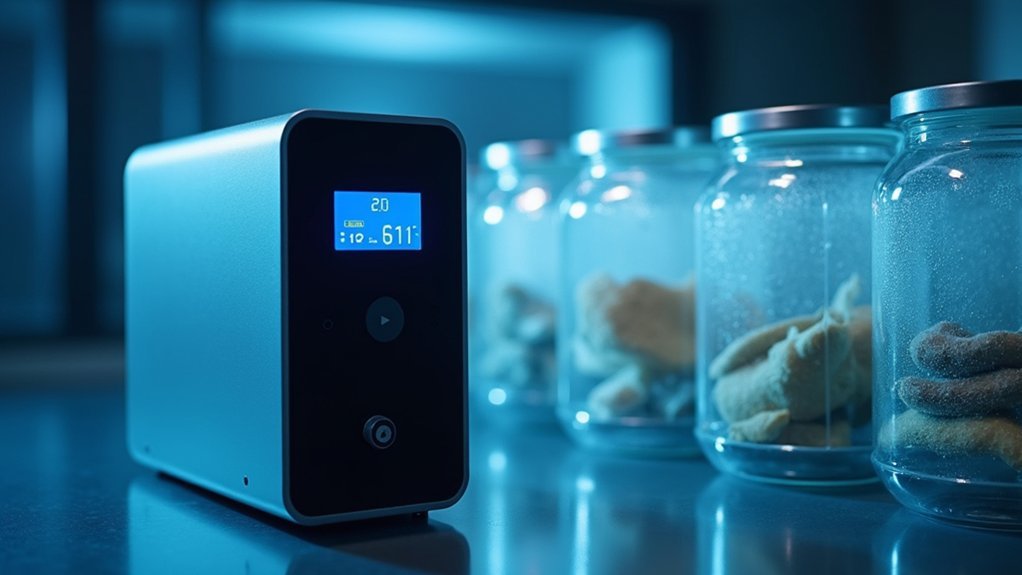
Beyond basic storage guidelines, you’ll need specific control methods to maintain ideal temperature and humidity levels for your PMC materials.
Temperature control systems should maintain consistent ranges between 0-5°C for refrigerated items, while freezing applications require -18°C to prevent bacterial growth effectively. You can implement pasteurization techniques using temperatures below 100°C to eliminate pathogens without compromising material integrity.
Humidity control becomes essential for preventing mold and bacterial growth, especially with dried or moisture-sensitive PMC components.
Advanced food preservation methods like vacuum packaging and modified atmosphere systems help you regulate both humidity and oxygen levels simultaneously. These techniques minimize oxidation and microbial growth, considerably extending your PMC materials’ shelf life and maintaining their quality standards.
Packaging Techniques to Prevent Contamination
Effective packaging serves as your primary defense against contamination once you’ve established proper temperature and humidity controls.
You’ll need to implement advanced packaging techniques that actively protect your products from environmental threats and extend their shelf life considerably.
Consider these essential food safety approaches:
- Vacuum packaging – You’ll eliminate air to prevent oxidation and microbial growth.
- Modified atmosphere packaging (MAP) – You can replace air with nitrogen and carbon dioxide to slow spoilage.
- Active packaging systems – You’ll incorporate oxygen scavengers and antimicrobial agents for enhanced protection.
- Advanced barrier materials – You’ll improve resistance to moisture, gases, and light contamination.
Dynamic packaging technologies that adjust internal atmospheres based on product respiration rates offer the most sophisticated protection available today.
Workspace Organization for PMC Conservation
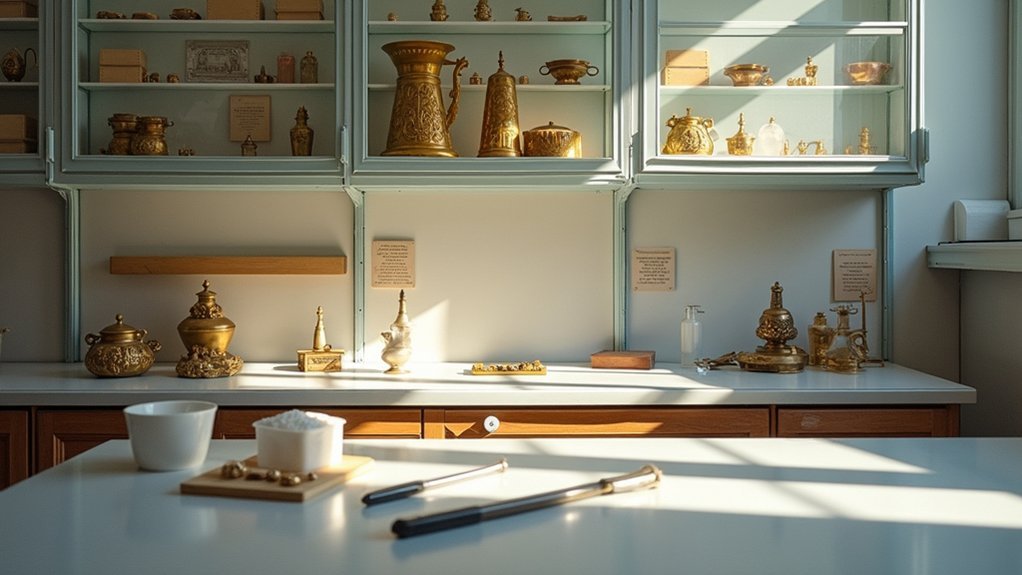
You’ll need to establish robust digital file management systems that categorize and protect your PMC documentation from corruption or loss.
Don’t overlook physical document storage solutions that shield sensitive materials from environmental damage and unauthorized access.
Your workspace organization directly impacts how effectively you can preserve and retrieve critical project information when it’s needed most.
Digital File Management Systems
When managing complex PMC projects, digital file management systems serve as the backbone of your organizational strategy, transforming how you store, access, and collaborate on critical project documentation.
These platforms centralize your project materials, ensuring team members can quickly locate essential files while maintaining proper workflow organization.
Effective digital file management systems enhance your project management capabilities through:
- Categorized workspace organization by project phases, stakeholders, and deadlines for streamlined workflows
- Version control features that track document changes and allow reverting to previous versions when necessary
- Cloud storage solutions providing secure backup and remote access across diverse geographical locations
- Integration with project management tools enabling seamless progress tracking and stakeholder communication
This systematic approach reduces time spent searching for information while maintaining document integrity throughout your PMC operations.
Physical Document Storage Solutions
While digital systems handle much of today’s project documentation, physical document storage remains essential for PMC operations that involve contracts requiring original signatures, regulatory compliance materials, and backup copies of critical project files.
You’ll need filing cabinets organized by project for efficient access to essential materials. Use labeled binders for each project phase to enhance document preservation and protect materials from damage.
Implement color-coding systems to quickly identify different document types like contracts and reports. Regular purging prevents clutter while maintaining updated storage indexes improves retrieval efficiency.
Invest in archival-quality storage materials, including acid-free folders and boxes, to extend your documents’ lifespan and maintain their integrity over time.
Tools and Equipment Maintenance for PMC Projects
Since PMC projects rely heavily on specialized tools and equipment to meet demanding timelines and quality standards, establishing a robust maintenance framework becomes critical to your project’s success.
You’ll need to implement scheduled maintenance protocols that prevent costly breakdowns and keep your operations running smoothly.
To maximize project efficiency, focus on these essential maintenance strategies:
- Deploy specialized software to track equipment usage, schedule maintenance tasks, and log all repair activities for thorough oversight.
- Train your personnel thoroughly on proper equipment handling and maintenance procedures to minimize accidents and equipment failures.
- Document all maintenance activities meticulously to guarantee accountability and support informed future investment decisions.
- Conduct regular inspections to identify potential issues before they escalate into project-disrupting problems.
Pre-Firing Preservation Strategies
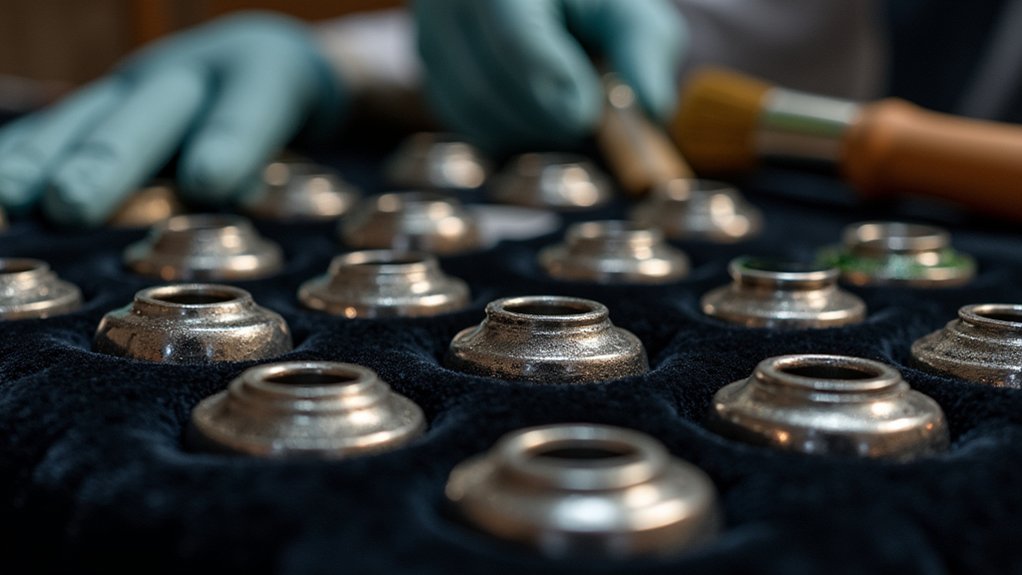
Just as equipment maintenance protects your project investments, implementing effective pre-firing preservation strategies protects your food products before cooking begins.
You’ll want to master several preservation techniques that maintain food quality while preventing spoilage. Refrigeration at 0-5ºC slows bacterial growth, extending shelf life considerably. For longer storage, freezing at -18ºC transforms water into ice, halting microbial activity while preserving nutrients. Vacuum packaging eliminates oxygen, reducing oxidation and bacterial proliferation effectively.
Consider high hydrostatic pressure as an advanced option—it inactivates harmful microorganisms without compromising sensory properties or requiring chemical preservatives.
Each method targets specific spoilage mechanisms: temperature control delays bacterial growth, vacuum packaging prevents oxidation, and pressure treatment destroys pathogens while maintaining nutritional integrity throughout storage.
Post-Firing Protection and Handling
Once you’ve completed the firing process, you’ll need to implement proper cooling protocols to prevent thermal shock that can crack or damage your PMC pieces.
You must also establish contamination prevention measures immediately after firing to protect the surface integrity of your work.
These critical steps guarantee your finished pieces maintain their structural soundness and aesthetic quality.
Immediate Cooling Protocols
Two critical hours determine whether your freshly cooked food remains safe or becomes a breeding ground for dangerous bacteria.
Immediate cooling protocols are vital for dropping temperatures from 140°F to 70°F within this timeframe, keeping your food out of the danger zone.
You’ll need to implement these rapid cooling strategies:
- Use ice water baths – Submerge containers in ice water for maximum heat transfer
- Choose shallow containers – They enhance cooling efficiency compared to deep vessels
- Employ blast chillers – Professional equipment accelerates temperature reduction
- Monitor temperature progression – Confirm food reaches below 41°F within six total hours
These immediate cooling protocols aren’t just about food safety—they’ll extend the shelf life of your products and confirm HACCP compliance, protecting both your customers and business reputation.
Contamination Prevention Measures
After establishing proper cooling procedures, your focus must shift to preventing contamination during post-firing protection and handling phases. You’ll need to implement extensive contamination prevention measures that target multiple risk points throughout your preservation process.
Effective handling practices form the foundation of contamination control. You should apply antimicrobial coatings to all surfaces and equipment, use gloves consistently, and sanitize frequently. Regular staff training programs enhance compliance while reducing foodborne illness risks.
| Prevention Method | Application | Benefit |
|---|---|---|
| Antimicrobial coatings | Surfaces/equipment | Pathogen elimination |
| Temperature control | Storage/transport | Bacterial growth prevention |
| Vacuum packaging | Distribution phase | Quality preservation |
| Staff training | All operations | Enhanced compliance |
These strategies greatly reduce microbial load, ensuring your products remain safe throughout handling and distribution.
Long-Term Storage Solutions for Finished Pieces
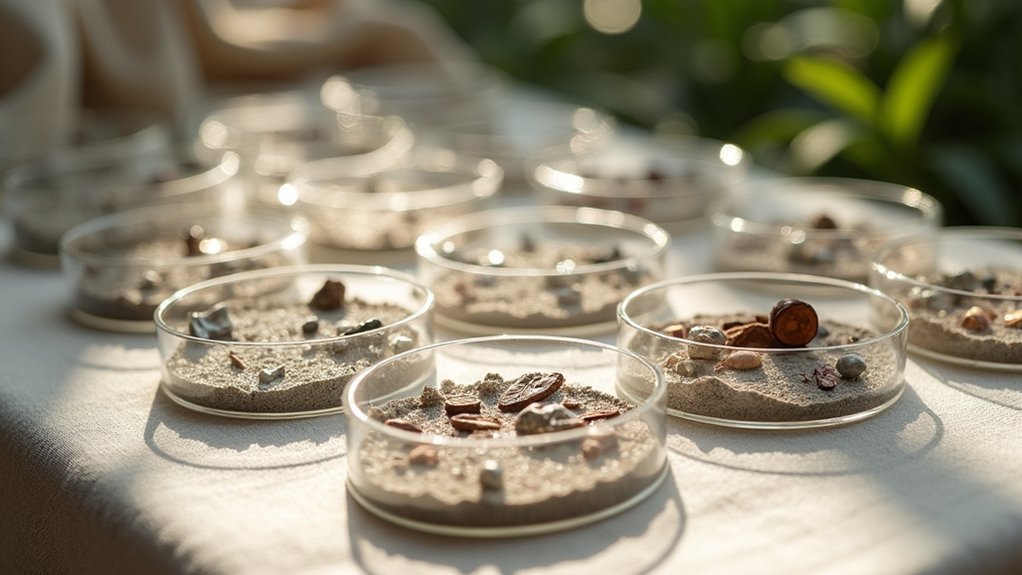
When you’ve invested time and effort into creating PMC pieces, protecting them from degradation becomes essential for maintaining their quality and extending their usable life.
Several advanced preservation methods can greatly reduce food waste while maintaining nutritional integrity.
Modern preservation technologies significantly minimize food spoilage while safeguarding essential nutrients and extending product viability.
Effective long-term storage solutions include:
- Vacuum packaging – Removes air to prevent oxidation and microbial growth, dramatically extending shelf life
- High pressure processing (HPP) – Uses 300-600 MPa pressures to inactivate pathogens while preserving sensory qualities in food processing
- Modified atmosphere packaging (MAP) – Replaces air with nitrogen and carbon dioxide to slow spoilage
- Cold plasma technology – Inactivates surface microorganisms without affecting heat-sensitive properties
These techniques guarantee your finished pieces maintain their intended characteristics throughout extended storage periods.
Documentation and Inventory Management
You’ll need robust digital record systems to track your PMC pieces and maintain their provenance over time.
Implementing asset tracking methods guarantees you can quickly locate specific items and monitor their condition status.
These documentation practices become critical when managing large collections or preparing pieces for long-term preservation.
Digital Record Systems
Digital record systems serve as the backbone of modern PMC operations, transforming how you document project phases and manage inventory across complex infrastructure initiatives.
These systems enable real-time tracking of project progress and resource allocation, ensuring you maintain complete visibility throughout every stage.
Cloud-based platforms revolutionize team collaboration by allowing access and updates from any location, eliminating data loss risks while promoting seamless coordination.
Your inventory management becomes markedly more efficient as you monitor material and equipment availability in real-time.
Key benefits include:
- Automated alerts that notify you about inventory levels and documentation deadlines
- Real-time tracking capabilities for project progress and resource allocation
- Streamlined workflows through integration with existing project management tools
- Enhanced decision-making through thorough reporting and analytics features
Asset Tracking Methods
Building on robust digital record systems, asset tracking methods form the operational framework that keeps your PMC projects running smoothly through precise documentation and inventory control.
You’ll want to implement digital inventory management systems that provide real-time visibility of all project assets. Barcoding or RFID technology enhances accuracy by eliminating manual errors and enabling quick asset identification. Regular audits and reconciliations guarantee your records remain current and discrepancies get addressed immediately.
Cloud-based asset management software facilitates seamless stakeholder collaboration, giving everyone instant access to critical information.
You should establish standardized documentation procedures that include detailed asset descriptions and maintenance schedules. This approach strengthens accountability while tracking each asset’s complete lifecycle throughout your project, guaranteeing nothing gets lost or overlooked.
Troubleshooting Common PMC Degradation Issues
Anyone working with PMC preservation will eventually encounter degradation issues that threaten product quality and shelf life.
When you’re facing these challenges, you’ll need targeted solutions that address the root causes while maintaining food integrity.
Here are four effective troubleshooting strategies:
- Implement high-pressure processing (HPP) – This technique’s effective at inactivating microorganisms without compromising nutritional value, extending shelf life considerably.
- Deploy hurdle technology – Combine multiple preservation methods to create hostile environments for pathogens while preserving quality.
- Utilize vacuum or modified atmosphere packaging – These methods limit oxygen exposure, preventing oxidation and microbial growth.
- Apply cold plasma technology – This innovation effectively eliminates surface contaminants while preserving texture and flavor characteristics.
Monitor storage conditions consistently to prevent future degradation issues.
Advanced Conservation Methods for Professional Studios
When you’re operating a professional culinary studio, you’ll need cutting-edge preservation methods that go beyond traditional techniques to maintain peak quality standards.
Advanced preservation techniques like High-Pressure Processing (HPP) effectively eliminate pathogens while preserving texture, flavor, and nutritional integrity.
High-Pressure Processing delivers superior pathogen elimination while maintaining the essential texture, flavor, and nutritional qualities that define professional culinary excellence.
Cold Plasma Technology uses ionized gas to deactivate microorganisms without heat damage, perfect for sensitive ingredients.
Pulsed Light Technology delivers intense light bursts that reduce microbial growth on surfaces, ensuring food security throughout preparation.
You’ll find Vacuum Packaging essential for preventing oxidation and extending shelf life by eliminating air exposure.
Modified Atmosphere Packaging (MAP) replaces oxygen with nitrogen and carbon dioxide, creating ideal storage conditions.
These methods collectively enhance your studio’s ability to preserve culinary creations while meeting professional quality standards.
Frequently Asked Questions
What Is the Best Preservative Method?
You’ll find the best preservative method depends on your specific food type and goals. HPP’s excellent for maintaining nutrition, while vacuum packaging works great for extending shelf life affordably and effectively.
How to Preserve a Kidney for Transplant?
You’ll need to flush the kidney with cold preservation solution like UW or Custodiol, then use hypothermic machine perfusion at 0-4°C. This maintains viability for up to 48 hours during transportation.
What Are 5 Methods of Food Preservation?
You can preserve food through refrigeration by keeping temperatures between 0-5ºC, freezing at -18ºC, canning with heat sterilization, pasteurization below 100ºC, and high-pressure processing using 300-600 MPa pressures.
What Are the Most Common Preservation Techniques?
You’ll find refrigeration and freezing are the most widespread techniques, followed by canning for long-term storage. You’ll also commonly see dehydration, pasteurization for liquids, and chemical methods like salting.
In Summary
You’ll master PMC preservation by controlling your storage environment and maintaining consistent temperature and humidity levels. Don’t forget to use proper packaging techniques and organize your workspace systematically. Keep detailed documentation of your inventory and address degradation issues promptly when they arise. If you’re running a professional studio, you’ll need advanced conservation methods to protect your investment. Remember, proper preservation techniques will extend your PMC’s lifespan considerably and guarantee better project outcomes.




Leave a Reply